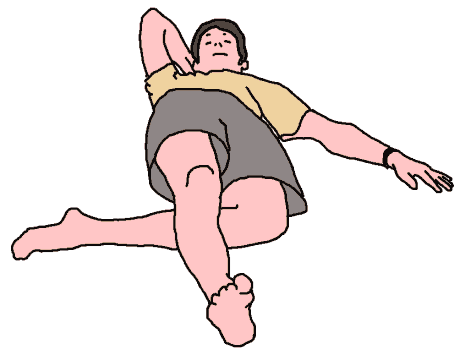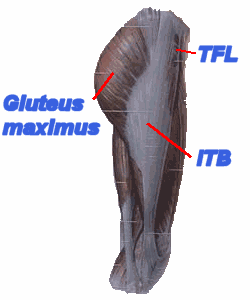|
|
|---|
This exercise challenges your lower back. Back pain sufferers, proceed with caution!
Lying Iliotibial Band Stretch:- Start Position
- Lie on your back with your left leg tucked under your right knee.
- For support, you put your left arm out to the side, and rest your head on your right hand.
Your right leg (the upermost leg) should take some of your weight.
- Chin gently tucked, scapulars anchored, pelvic neutral.
Lying Iliotibial Band Stretch:-:- Action
- Strongly zip and hollow and breathe in.
- (Maintain zip and hollow): Relax your right leg and let the weight of your hips do the stretch.
- Maintain zip and hollow, & breathe normally.
- Hold the position for up to 30 seconds. Occasionally engage your left Gluteus maximus,
and push down with your left hand.
- When your time is up, get up and walk around to let the stretched Iliotibial band
relax back to its working length.
- Repeat the stretch on the opposite side!
Lying Iliotibial Band Stretch:-, TFL-ITB Stretch, Cause of Iliotibial Band syndrome, pictures (Scroll right>>>...)
|
Lying Iliotibial Band Stretch:- Start Position and Action:-

What this exercise does-
|
Picture: :- The Iliotibial Band, Tensor fascia lata and related structures:-
Note the huge area of attachment with the Gluteus maximus! See Discussion to right.

|
- Stretches your Iliotibial Band while it is none weight bearing.
Watch Points for Iliotibial Band Stretch (Lying)
- Maintain a strong zip and hollow, and don't let the pelvic "clock face" look down!
- Keep the scapulas anchored.
© Bruce Thomson, EasyVigour Project
scroll up^^^^.....
|
|
Cause of Iliotibial Band Syndrome
The Iliotibial band gets into problems because the Tensor fascia lata becomes
the dominant iliotibial band (ITB) tensioner. The Tensor fascia lata should actually share this
function with the Gluteus maximus(3).
Postural defects that cause iliotibial band syndrome:-
- Sway back, which is a sign of a lazy Gluteus maximus(2)
- Inward looking knee caps ("knock knees")(1,2).
- If only one Iliotibial band is tight, it is probable that your pelvis is
rotating to "look" toward the side of the tight Iliotibial band(1,2).
Treatment of Iliotibial Band Syndrome
- Recognize that there is major damage and trigger point activity in your Tensor fascia lata muscle(3).
- Mobilize, or stretch as described here.
- Encourage your Gluteus maximus to strengthen and to "engage at heel strike".
- Treat the trigger points in the Tensor fascia lata! - The Gluteus medius and
minimus will have trigger points as well (further info - Triggerpoint Therapy Workbook...).
Reference
- Shirley A Sahrman: "Movement Impairment Syndromes" Publ. Mosby, 2002
ISBN 0-8016-7205-8
- Bruce Thomson: Engage Gluteus maximus!
Also: Tensor Fascia Latae Stretch
- Clair Davies: Triggerpoint Therapy Workbook) - Publ. New Harbinger Publications 2001
|

